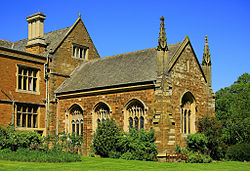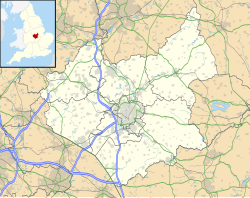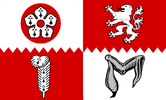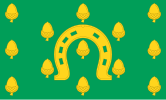|
Launde Priory
Launde Priory is a former Augustinian priory in Leicestershire, England. Its successor Launde Abbey is used as a conference and retreat centre by the Church of England dioceses of Leicester and Peterborough. HistoryLaunde Priory was founded c.1119 by Richard Basset and his wife, Maude, who endowed the priory with the advowsons of the churches of Ab Kettleby, Frisby on the Wreake, Holt, Oadby, Welham and Witherley, all within Leicestershire; Ashby, Weldon and Weston by Welland in Northamptonshire; Hathersage in Derbyshire; Colston Bassett in Nottinghamshire; Wardley in Rutland; and Pattingham in Staffordshire. They also donated the village of Loddington in Leicestershire; this donation probably also included the advowson of Loddington church.[1][2] Within 50 years, from other benefactors, Launde also gained the churches of Grimston, Rotherby and Tilton in Leicestershire; Glaston in Rutland. The priory also gained the manor of Frisby-on-the-Wreake in Leicestershire: this was seized by King Henry II although subsequently returned.[1] Within the next century the priory acquired yet more churches, including Ashby Folville, Shoby and Peatling Parva in Leicestershire, and Arthingworth, Blatherwick and Little Bowden in Northamptonshire.[1] The priory did not remain in control of all of its possessions, however, and lost many throughout its existence.[1] In the mid 15th-century, the priory was visited by William Alnwick, Bishop of Lincoln. The visit reveals that the priory was home to 10 canons when previously there had been 18, and that the priory's income had fallen from 1000 marks, to only 400. These problems were attributed to a series of bad priors and an era of bad management. It was a period of decline which would continue until dissolution.[1] In 1528 the priory was recorded home to the prior, 9 canons and 4 novices. The priory was, however, in poor condition. The refectory was in ruins and the priory church "dilapidated".[1] The Valor Ecclesiasticus of 1535 recorded the priory as having an annual income, after expenses, of around £400.[1] The priory was finally dissolved in December 1539, and the prior was awarded an annual pension of £60. Thomas Cromwell had been interested in the priory's property since 1528, and he ensured the priory was granted to himself following dissolution.[1] Cromwell built himself a new manor house on top of the former priory site. This house is known as Launde Abbey. Part of the former priory church (part of the crossing of the chancel) were incorporated into a new chapel attached to the new house.[2]  Gregory Cromwell, 1st Baron Cromwell was buried in that chapel. Priors of Launde PrioryA list of the Priors of Launde:
Other burialsReferences |
||||||||||||||||||||||||||



